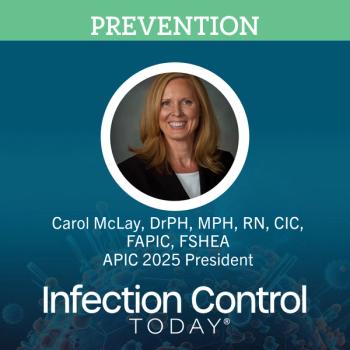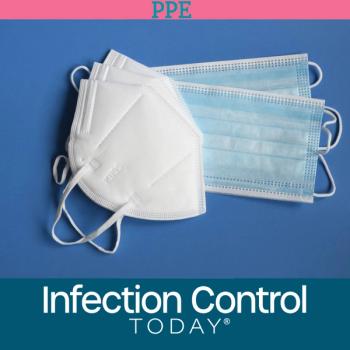
Gloved Hands, Surfaces are Common Culprits in Cross-Contamination
By now, most healthcare providers realize that hand-to-surface transmission can account for a significant amount of cross-contamination when the healthcare worker then proceeds to touch the patient, items in the patient’s immediate surroundings and then moves on to another patient room without proper hand sanitation. It is important to remember that gloved hands should be treated the same as bare hands – the glove also becomes contaminated and should be considered a reservoir for pathogenic organisms. Boyce (1997) found that when nurses touched surfaces such as bed rails, blood pressure cuffs, computer keyboards, door knobs, over-bed tables, patient gowns and linens, their glove became contaminated 42 percent of the time.
At right, a healthcare worker's hands on a bedrail can leave contamination visible under black light. Photos courtesy of Kimberly-Clark Health Care.
Gloves have been implicated in the transmission of Clostridium difficile (C. diff), a significant hospital pathogen capable of causing great damage and distress to patients. C. diff now accounts for 15 percent to 25 percent of all antibiotic-associate disease, and there are as many as 3 million new cases of Clostridium difficile infection annually.
“There are two major potential reservoirs of C. difficile in hospitals — the infected patient and contaminated inanimate objects — from bedrails, linen and patient gowns to blood pressure cuffs, computer keyboards and door knobs,” says Wave Truscott, PhD, MBA, director of scientific affairs and clinical education for Kimberly-Clark HealthCare. “One critical item that readily becomes contaminated and easily contaminates other items are gloves. The contaminated surface of a glove is unfortunately a great way for C. difficile to be transported from one place to another. Healthcare workers wearing gloves contaminated with C. diff as they do their job can spread it by simply typing in patient information on a keyboard or patient chart, using the phone or opening the door. Then the question is who is going to touch the now contaminated keyboard, door knob or telephone and take the pathogens — where?”
According to guidance from the Centers for Disease Control and Prevention (CDC), a new pair of gloves should be used for every patient to avoid cross-contamination. Wearing the same gloves from previous patient-care activity and washing them with soap and water is not acceptable. To underscore this point, Doebbling et al (1998) retrieved a significant amount of microorganisms from the hands of healthcare workers who were merely washing their gloved hands between patients instead of donning a fresh pair.
It is also imperative to engage in thorough and proper surface cleaning to combat persistent pathogens such as C. diff, whose spores can remain viable for weeks, months, years depending on the host environment.
“Hospitals need to focus on frequently-touched surfaces in their daily cleaning process,” Truscott says. “The CDC recommended a 5,000 ppm free chorine solution for disinfection until there were Environmental Protection Agency(EPA)-approved sporicidal disinfectants available on the market – which there are now, and more are coming.” Truscott says hospitals should ask some of the following questions when comparing sporicidal disinfectants:
• Has it been tested against C. difficile?
• What inactivates it (feces, blood?) and how much?
• Is pre-cleaning usually required or is it an all-in-one process?
• How much “wet contact” time is required to kill spores?
• Does it stay wet long enough for spore kill, or dry out?
• Is it easy to use: flip top, single use, one hand grab, single-use dispense, etc.?
• Is there some abrasiveness on wipes to enable disruption of soil?
• Will it remain active for the reasonable use-life of the container?
• Is it a spray? Spray aerosols: can damage electronics, may cause irritation – user or patient
• Is it compatible with surfaces it must disinfect?
Reference:
Boyce JM Infect Control Hosp Epidemiol 1997;18:622-627.
Newsletter
Stay prepared and protected with Infection Control Today's newsletter, delivering essential updates, best practices, and expert insights for infection preventionists.






